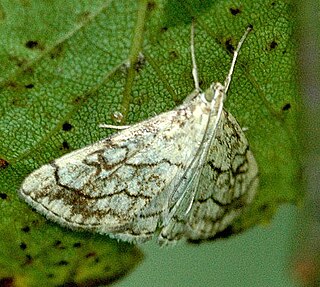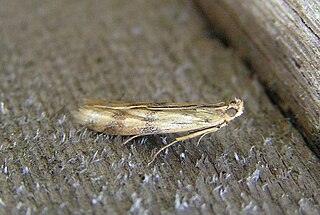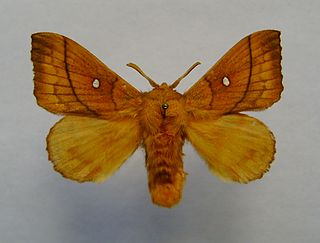
Moths are a paraphyletic group of insects that includes all members of the order Lepidoptera that are not butterflies, with moths making up the vast majority of the order. There are thought to be approximately 160,000 species of moth, many of which have yet to be described. Most species of moth are nocturnal, but there are also crepuscular and diurnal species.

The Gelechiidae are a family of moths commonly referred to as twirler moths or gelechiid moths. They are the namesake family of the huge and little-studied superfamily Gelechioidea, and the family's taxonomy has been subject to considerable dispute. These are generally very small moths with narrow, fringed wings. The larvae of most species feed internally on various parts of their host plants, sometimes causing galls. Douglas-fir (Pseudotsuga) is a host plant common to many species of the family, particularly of the genus Chionodes, which as a result is more diverse in North America than usual for Gelechioidea.
Ebbe Schmidt Nielsen was a Danish entomologist. Nielsen was influential in systematics and Lepidoptera research, and was an early proponent of biodiversity informatics. The journal Invertebrate Systematics was established with significant contributions from Nielsen and he assisted in the founding of the Global Biodiversity Information Facility (GBIF). Nielsen authored several books, published over eighty scientific papers, and was highly regarded within the scientific community. Following his death, the GBIF organised the Ebbe Nielsen Prize in his memory, awarded annually to promising researchers in the field of biodiversity informatics. The moth Pollanisus nielseni is dedicated to Nielsen.

The Pyraloidea are a moth superfamily containing about 16,000 described species worldwide, and probably at least as many more remain to be described. They are generally fairly small moths, and as such, they have been traditionally associated with the paraphyletic Microlepidoptera.

Bombycoidea is a superfamily of moths. It contains the silk moths, emperor moths, sphinx moths, and relatives. The Lasiocampoidea are close relatives and were historically sometimes merged in this group. After many years of debate and shifting taxonomies, the most recent classifications treat the superfamily as containing 10 constituent families. Their larvae often exhibit horns.

Evergestinae is a fairly small subfamily of the lepidopteran family Crambidae, the crambid snout moths. The subfamily was described by H. Marion in 1952. It contains roughly 140 species on all continents and continental islands. Evergestine moths resemble Pyraustinae; however, the male genitalia have a long uncus and long, slender gnathos. The larvae feed mostly on Brassicaceae.
Agathiphaga is a genus of moths, known as kauri moths. It is the only living in the family Agathiphagidae. This caddisfly-like lineage of primitive moths was first reported by Lionel Jack Dumbleton in 1952, as a new genus of Micropterigidae.

Acrobasis tumidana is a moth of the family Pyralidae. It was described in 1775 by Michael Denis and Ignaz Schiffermüller and is found in Europe.

Catoptria lythargyrella is a species of moth of the family Crambidae. It is found in Europe.

Udea ferrugalis, the rusty dot pearl, is a moth of the family Crambidae. The species was first described by Jacob Hübner in 1796.
Micromartinia is a genus of moths of the family Crambidae. It contains only one species, Micromartinia mnemusalis, which is found in Costa Rica, Brazil, French Guiana and Venezuela.

Homoeosoma sinuella is a moth of the family Pyralidae. It is found in Europe.

Homoeosoma nimbella is a moth of the family Pyralidae. It is found in Europe.

Thopeutis is a grass moth genus of subfamily Crambinae, tribe Haimbachiini. Some authors have placed it in the snout moth family (Pyralidae), where all grass moths were once also included, but this seems to be in error.

The Phycitini are a tribe of moths of the family Pyralidae.
The Global Lepidoptera Names Index (LepIndex) is a searchable database maintained by the Department of Entomology at the Natural History Museum, London.

The Anerastiini are a tribe of moths of the family Pyralidae.

Evergestis aenealis is a species of moth in the family Crambidae. It is found in most of Europe, except Ireland, Great Britain, the Benelux, Portugal, Slovenia and Ukraine.
Psara intermedialis is a moth in the family Crambidae. It was described by Hans Georg Amsel in 1956 and is found in Venezuela.

Odonestis pruni is a species of moth, belonging to the family Lasiocampidae. It was first described by Carl Linnaeus in his landmark 1758 10th edition of Systema Naturae.











